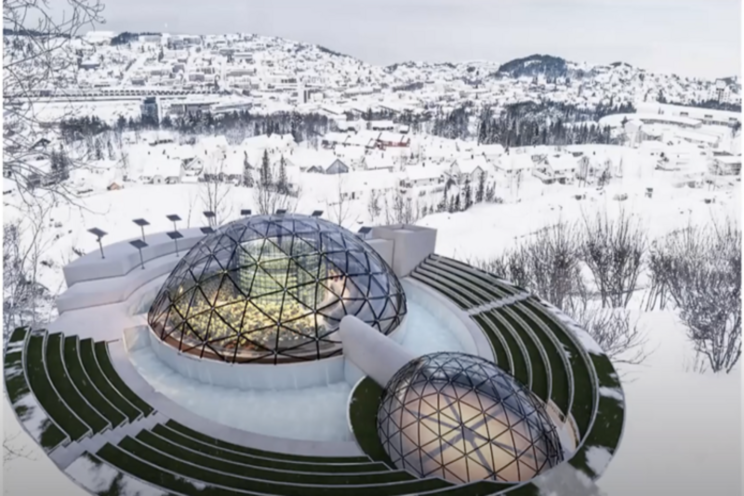The ambitious solution to feed remote Northern communities
Added on 26 August 2021

Watch Hala Al Amine's Full Presentation On This Concept
A jug of milk in some aboriginal communities in northern Canada can cost as much as $15, and a single apple can set residents back $1-2.
These scattered small urban areas are not only challenged by harsh weather conditions, they're increasingly distressed by the limited means available to cultivate. Growing seasons in these locations can be as short as 3 months.
As a result, they're forced to survive on expensive store-bought goods, largely non-perishable goods that aren't able to supply the appropriate amount of nutrition. This greatly impacts the cost of living and community development.
So, How Do We Build A Stable And Secure Food System For These Communities?
This is the challenge architect and landscape architect, Hala Al Amine, took on during her Master's Degree. After having realized the severity of food insecurity that these communities face and the exorbitant prices they're expected to pay for fresh produce, Al Amine felt compelled by the opportunity to help these communities be self-sustainable and reduce their dependence on southern provinces.
"The project led me to research and study the needs and cultures of these communities, to understand their history and eating habits, and moreover to study the geography and climate of their settlement areas."
— HALA AL AMINE
She continued to develop an interest in this topic when she decided to participate in Agritecture Studios to design solutions for urban food access and resilience.
With her architectural background and knowledge of the specific cultural and climatic restrictions of these communities, Al Amine set out to design a food hub that could ensure this food security for remote northern locations.
Envisioning The Arctic Eye

A rendering of Hala Al Amine's for the Remote Northern Communities challenge area
Al Amine chose to locate her project in Iqaluit, the capital of Nunavut, Canada.
Taking inspiration from the classic igloo shape, she developed plans for what she calls the "Arctic Eye." Her goal was to address the "planting challenges these communities suffer from by extending the growing season to all year round and improving the plant yield with minimum energy usage."
Mimicking the shape of the Igloo, the design is composed of a glass geodesic dome that hosts a greenhouse at its periphery, and a vertical farm in the center of the operations. With this design in mind, Al Amine selected crops based on both the nutritional diets of these remote communities, and the tolerance levels of the crops to the cold.
Al Amine designed the greenhouse such that it could make the best use of the natural sunlight for the 3 hours that the sun is up in wintertime, but also included supplemental lighting to ensure optimal plant growth and the best possible yield year-round.
Considering How Sustainable The Farm Could Be

A rendering of Hala Al Amine's for the Remote Northern Communities challenge area
Al Amine made it a point to consider the sustainability and energy efficiency of this project throughout the designing process, believing it to be "key factors in the success of any urban farm in the North."
According to Hala, while the glass greenhouse allows the sun to be the prominent source of light and heat while natural lighting is available, "excess heat generated from the artificial lighting in the vertical farm will be transferred directly to the greenhouse, regulating the temperature of both the greenhouse and the vertical farm." The Arctic Eye also sports "a rainwater collector around the dome thus reducing the water consumption" of the model.
Moreover, Al Amine says that "the project acts as a social enterprise that brings the community members together through connecting them to nature and by providing planting lessons and training sessions."
To allow for future expansion, the design has been planned such that it "can be scaled horizontally along different sides, thus providing more yield for bigger communities."
Now that Hala had a design in place, she needed to assess the feasibility of her project. What she needed was the right tools to support her in estimating annual yield, costs, how many mouths the model could feed, energy consumption, etc.
Enter Agritecture Designer.

A rendering of Hala Al Amine's for the Remote Northern Communities challenge area
Through this software, Al Amine was able to build a farm model that could meet the daily vegetable needs of approximately 1,000 local inhabitants. Her vertical farmed microgreens and salad mixes could feed approximately 552 people in just 175m2 of floor space, and the greenhouse-grown tomatoes, peppers, kale, spinach and bok choy could feed 474 people with an area of 1175m2 (These figures assume that a "person fed" receives their 3 daily servings of vegetables entirely from the output of the farm).
Al Amine says that "both these planting techniques and the selection of cold-tolerant plants maximize the annual yield without increasing the expenses" of the project.
"Agritecture Designer is user friendly and customizable according to the geographic location and selected crops. The financial model that AD provides helps in specifying the crops to be planted, the planting techniques, and the size of the farm in order to design a successful farm."
— HALA AL AMINE
With this data backing up Al Amine's vision for a food hub for remote northern communities, we're excited to see how this project gets actualized. Get started with Designer today to make your urban agricultural dreams a reality!
Editor's note: The following information is derived from an interview Agritecture conducted with architect / landscape architect, Hala Al Amine, as part of Agritecture Studios. This first virtual cohort supported architects with a deep interest in urban agriculture who lacked the technical background necessary to move forward with their concepts confidently. Learn more about Agritecture Studios' first cohort here!
Photo Caption: A rendering of Hala Al Amine's for the Remote Northern Communities challenge area
Source and Photo Courtesy of Agritecture
Source: Agritecture
More news















